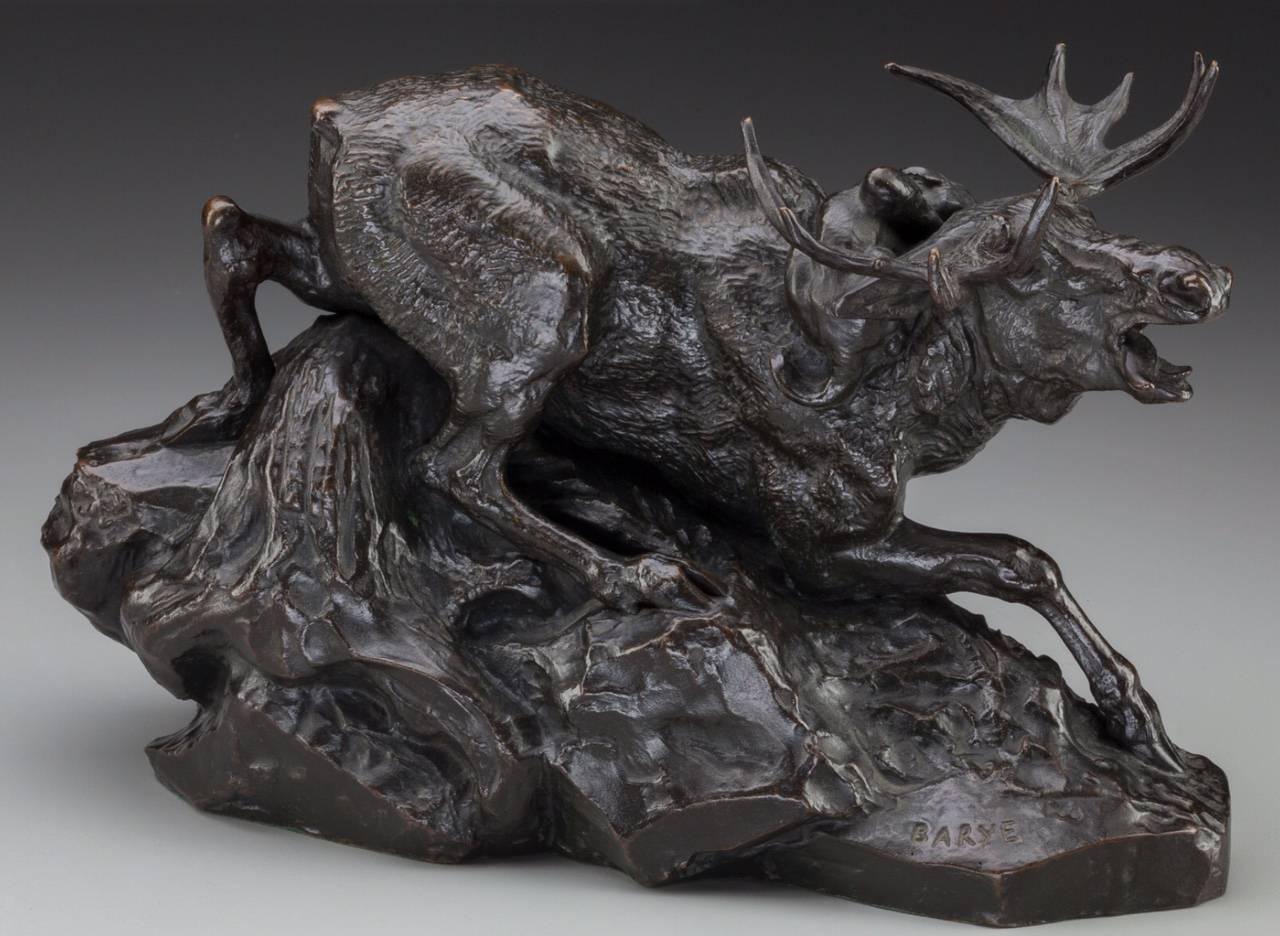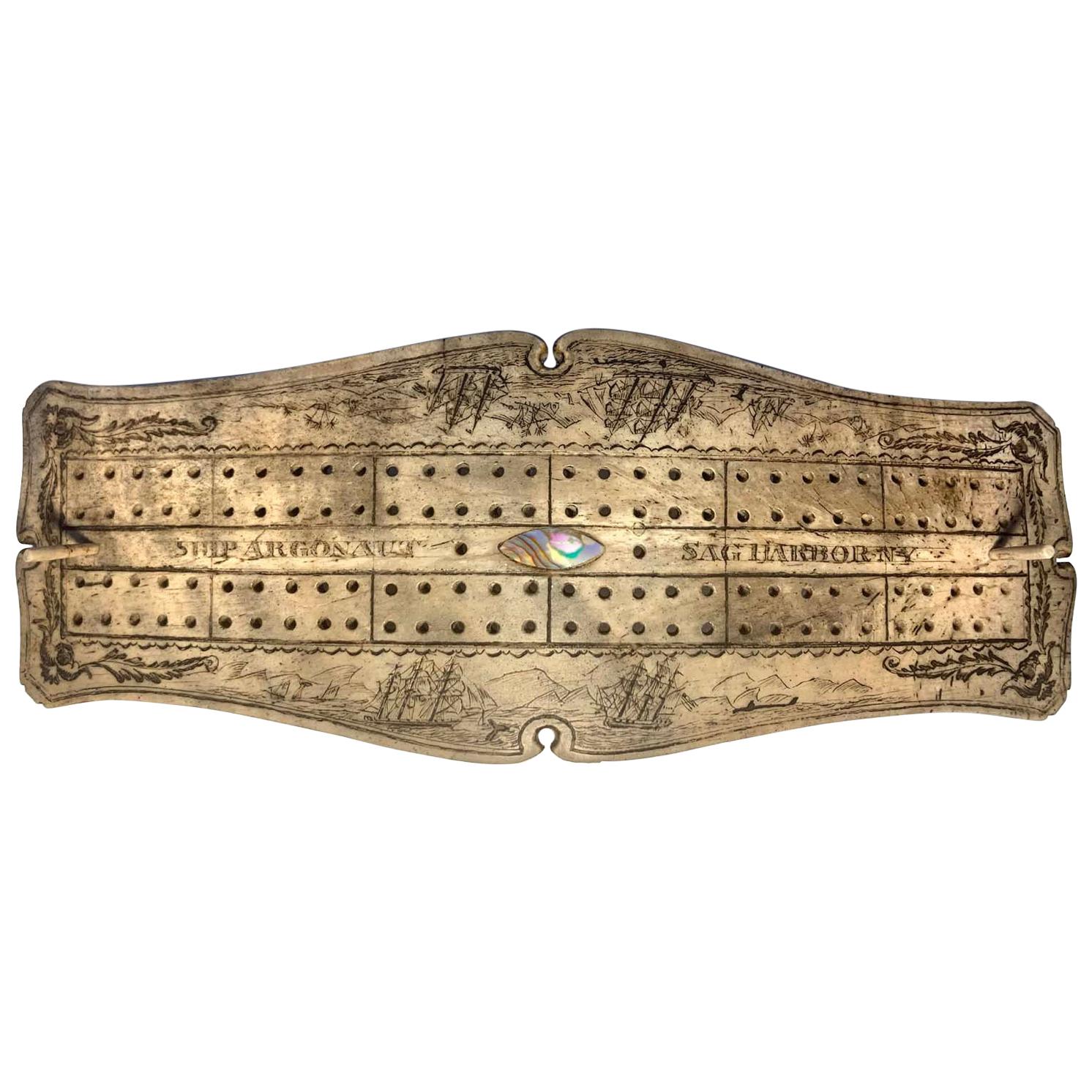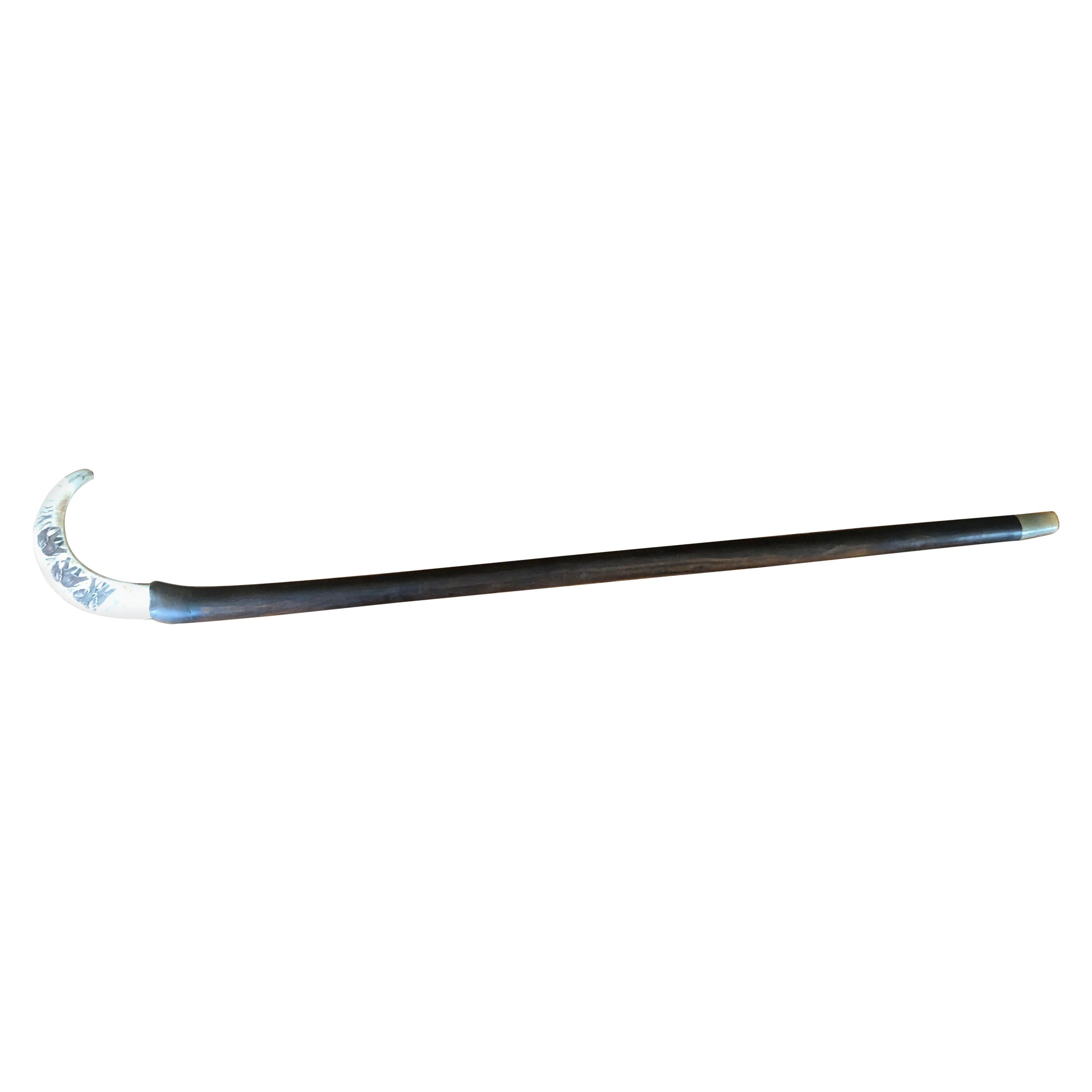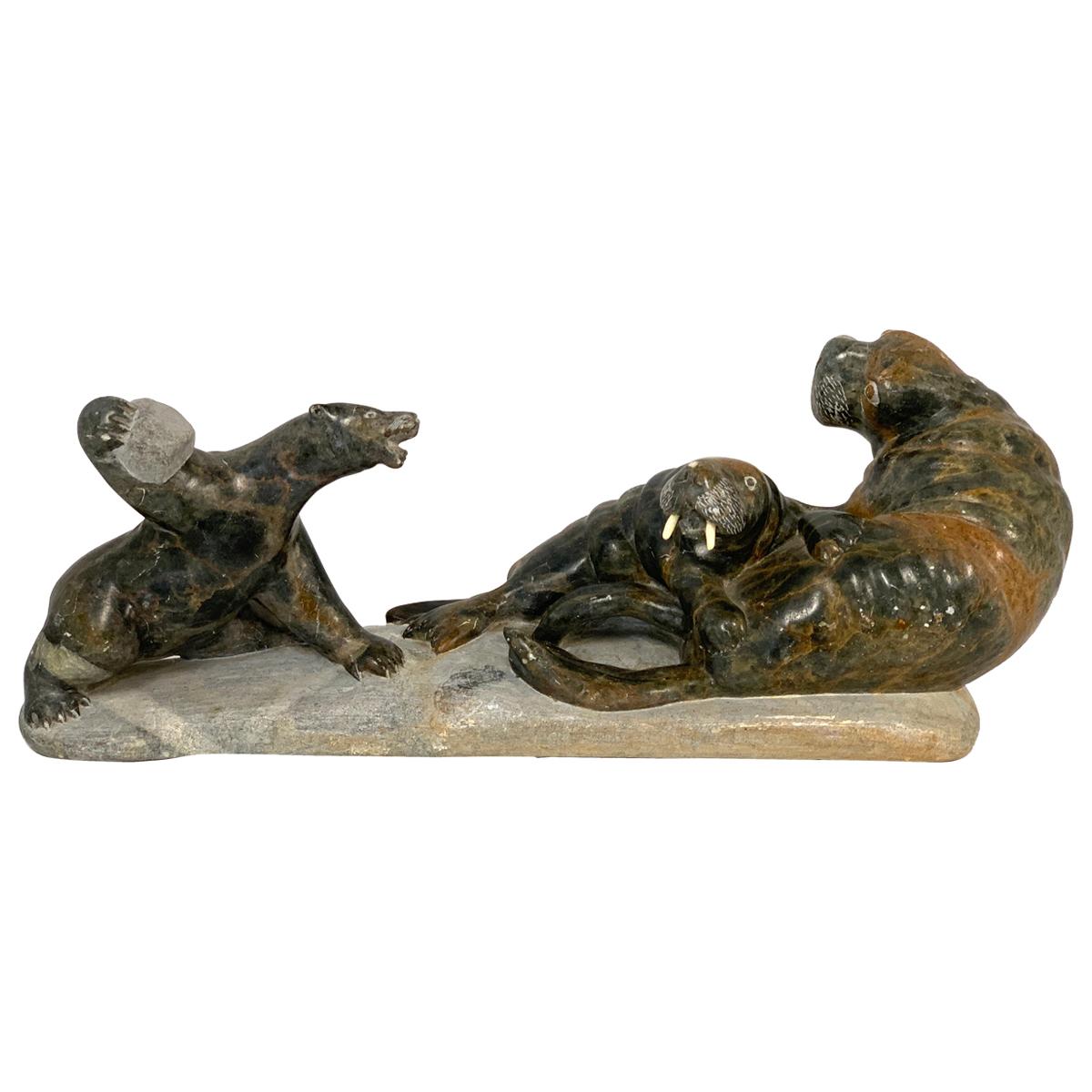Items Similar to Pair Inuit Seal and Whale Scrimshaw Walrus Ivory Tusks
Want more images or videos?
Request additional images or videos from the seller
1 of 12
Pair Inuit Seal and Whale Scrimshaw Walrus Ivory Tusks
About the Item
A pair of antique Alaskan walrus tusks with scrimshaw decoration, one with three different whales the other with three different seals.
Alaska, United States
Length: 29.5 Inches.
Condition: Some wear and abrasions.
- Dimensions:Height: 2 in (5.08 cm)Width: 1.5 in (3.81 cm)Depth: 29.5 in (74.93 cm)
- Style:Tribal (Of the Period)
- Materials and Techniques:
- Place of Origin:
- Period:1900-1909
- Date of Manufacture:1900
- Condition:Wear consistent with age and use.
- Seller Location:Dallas, TX
- Reference Number:1stDibs: LU1774239343052

About the Seller
4.9
Gold Seller
These expertly vetted sellers are highly rated and consistently exceed customer expectations.
Established in 2000
1stDibs seller since 2015
403 sales on 1stDibs
Typical response time: 1 hour
- ShippingRetrieving quote...Ships From: Dallas, TX
- Return PolicyA return for this item may be initiated within 7 days of delivery.
More From This SellerView All
- Brazilian Wai Wai Tribal Cassava Graters Circa 1945Located in Dallas, TXBrazilian Wei Wei Casava Graters Two graters constructed of wood and sharpened rock used by the Wai Wai Indigenous tribe of Northern Brazil to process raw Cas...Category
Vintage 1940s Brazilian Folk Art Antiquities
MaterialsStone
- Pair of Han Dynasty Pottery Horses and Equestrian RidersLocated in Dallas, TXA wonderful pair of Ex Sotheby’s painted Polychrome Equestrian Horse and Riders made from gray pottery, Presents beautifully and guaranteed authentic with provenance and COA. Measures: Height 11.5 inches and width 11 inches Condition: Possible professional restorations but not detectable. Provenance: Sotheby’s London. 16th November, 1999. Lot 12 (2 of 4 horses in that lot). Sotheby’s New York, NY September 14, 2019. The importance of the horse in the history and culture of China can be viewed, in part, through the artistic legacy of this great civilization. In sculpture, painting, and literature, horses were glorified and revered. Horses were believed to be related to mythological dragons, reflecting their sacred status within society. During the unification of China under the Han Dynasty, bands of mounted nomadic warriors from the north threatened the country. In order to thwart their attacks, the Chinese sought to import stronger, faster steeds from Central Asia (as opposed to the Mongol ponies used by the invaders), eventually leading to the creation of the Silk Road. This small sculpture of a mounted soldier reveals the crucial military role of the horse. When compared to the diminutive stature of the rider, the importance of the horse becomes readily apparent. This creature provided security and strength, allowing the Empire to secure its borders and expand its influences across Central Asia. The magnificent regalia of the horse, including a brilliantly painted saddle in red and green/gold, reflect the respect this animal received. The warrior as well is gorgeously decorated with a painted red tunic and gray chest...Category
Antique 15th Century and Earlier Chinese Chinoiserie Animal Sculptures
MaterialsPottery
- Pair of Han Dynasty pottery Horses and Equestrian RidersBy Emile GalléLocated in Dallas, TXA wonderful pair of Ex Sotheby’s painted Polychrome equestrian horse and riders made from gray pottery, presents beautifully and guaranteed authentic with provenance and COA. Measures: Height 11.5 inches and width 11 inches Condition: Possible professional restorations but not detectable. Provenance: Sotheby’s London. 16th November, 1999. Lot 12 (2 of 4 horsed in that lot) Sotheby’s New York, NY September 14, 2019. AVANTIQUES is dedicated to providing an exclusive curated collection of Fine Arts, Paintings, Bronzes, Asian treasures, Art Glass and Antiques. Our inventory represents time-tested investment quality items with everlasting decorative beauty. We look forward to your business and appreciate any reasonable offers. All of our curated items are vetted and guaranteed authentic and as described. Avantiques only deals in original antiques and never reproductions. We stand behind our treasures with a full money back return if the items are not as described. The importance of the horse in the history and culture of China can be viewed, in part, through the artistic legacy of this great civilization. In sculpture, painting, and literature, horses were glorified and revered. Horses were believed to be related to mythological dragons, reflecting their sacred status within society. During the unification of China under the Han Dynasty, bands of mounted nomadic warriors from the north threatened the country. In order to thwart their attacks, the Chinese sought to import stronger, faster steeds from Central Asia (as opposed to the Mongol ponies used by the invaders), eventually leading to the creation of the Silk Road. This small sculpture of a mounted soldier reveals the crucial military role of the horse. When compared to the diminutive stature of the rider, the importance of the horse becomes readily apparent. This creature provided security and strength, allowing the empire to secure its borders and expand its influences across Central Asia. The magnificent regalia of the horse, including a brilliantly painted saddle in red and green/gold, reflect the respect this animal received. The warrior as well is gorgeously decorated with a painted red tunic and gray chest...Category
Antique 15th Century and Earlier Chinese Han Animal Sculptures
MaterialsPottery
- Pair Ming Dynasty Glazed Pottery Dignitary FiguresLocated in Dallas, TXA pair of Ming dynasty sancai blue glazed pottery figures. Circa 1500 AD Ming Dynasty I have owned over 250 ming tomb figures including over 80...Category
Antique 16th Century Chinese Ming Figurative Sculptures
MaterialsPottery
- Green Glazed Shiwan Pottery Teapots Qing Dynasty, 'Pair'Located in Dallas, TXA near pair of 19th century Sancai green glazed pottery teapots. Both with yoked handles, spouts and lids. Both also have the Republic era official government wax red seal signifying...Category
Antique 1880s Chinese Chinese Export Pottery
MaterialsPottery
- 17th Century Pair of Lombardian Italian Swiss Carved ChairsLocated in Dallas, TXPair of Lombardian maple and walnut post chairs, 17th century. Richly hand-carved and inlaid in maple and walnut perfect for accent or hall chairs. Design ...Category
Antique Late 17th Century Italian Renaissance Revival Chairs
MaterialsWood
You May Also Like
- Sag Harbor Whale Scrimshaw Cribbage BoardLocated in Sag Harbor, NYAuthentic Scrimshaw carved into and antique tortoise shell with brass legs. Carved aboard the Ship Argonaut. A whaling ship from Sag Harbor New York from 1814-1832. The detailed carv...Category
Antique Early 19th Century American Folk Art Antiquities
MaterialsTortoise Shell
- Antique Walking Stick with Horn Handle Adorned with Elephant ScrimshawLocated in San Diego, CAFabulous antique walking stick with horn handle decorated with elephant scrimshaw, circa 1900. The handle is a curved horn with a pack of el...Category
Early 20th Century American Antiquities
MaterialsHorn, Hardwood
- Inuit Sculpture, Bear Attacking WalrusLocated in Palm Springs, CAA whimsical large Inuit Eskimo carving in soapstone of a Bear holding a rock to throw at 2 Walrus. The tusks of one walrus are likely bone, and th...Category
20th Century Canadian Native American Objects
MaterialsSoapstone
- Inuit Soapstone SealLocated in Mexico City, MXAn Inuit green seal. The piece has a signature: "Kilabuk".Category
Mid-20th Century Canadian Folk Art Sculptures and Carvings
MaterialsSoapstone
- Hand Carved Ivory Coast Tribal Ritual and Festival Mask from the Dan TribeLocated in Monrovia, CAHand Carved Ivory Coast Tribal Ritual and Festival Mask From The Dan Tribe. Antique "Dan Tribe" Tribal Mask Originally from Ivory Coast. Carved T...Category
Early 20th Century African Folk Art Antiquities
MaterialsWood
- Inuit Soapstone Seal HunterLocated in Mexico City, MXA Inuit carved dark green soapstone seal hunter. The sculpture is signed and dated 1974 on the bottom by an unidentified artist.Category
Vintage 1970s Canadian Folk Art Sculptures and Carvings
MaterialsSoapstone





